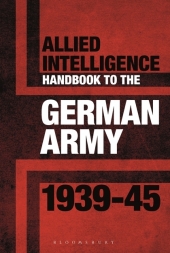 Neuerscheinungen 2017Stand: 2020-02-01 |
Schnellsuche
ISBN/Stichwort/Autor
|
Herderstraße 10
10625 Berlin
Tel.: 030 315 714 16
Fax 030 315 714 14
info@buchspektrum.de |

Stephen Bull
Allied Intelligence Handbook to the German Army 1939-45
2017. 192 S. 25 black and white illustrations and photographs. 7.086614 in
Verlag/Jahr: BLOOMSBURY TRADE; CONWAY 2017
ISBN: 1-84486-426-X (184486426X)
Neue ISBN: 978-1-84486-426-3 (9781844864263)
Preis und Lieferzeit: Bitte klicken
A fascinating compilation of information that the Allied forces gathered about the Germans during the Second World War.
What did the British or American soldier know about the German Army? Was this knowledge accurate - and just how did he know it? There have been several ´handbooks´ of Second World War armies, but they never tell us exactly what the Allied soldier knew at the time, or how he was informed. This is of importance because it influenced both conduct on the battlefield, and the way in which the soldier thought about his enemy. The book explains the background history of the organisations involved, followed by short chapters based around a series of original documents. This puts the original into context and also discusses whether the document that follows was correct in the picture it painted, and what can be deduced about sources and the concerns of the intelligence officers who compiled the material. Most of the documents were produced at the time, by the British War Office or US War Department, and cover different aspects of the German Army, including tactics, weapons, and uniforms.16
ubjects include: Allied intelligence on the German Army from 1930 onwards, British SIS / MI6 and US Military Intelligence. The organisations responsible, how they worked, and how they changed very rapidly with the coming of war. The role of technology, modern - like the radio transmitter, ancient - as in scouring libraries and periodicals, reports on military manoeuvres and parades. Limitations of ´Ultra´ The German army itself, from the tiny force left after Versailles, to the rapid expansion in the late 1930s. Innovation in tanks, tactics, machine guns, rocket weaponry. The problems of gathering intelligence, not just danger, but finance, asking the right questions and the limitations of reporting and distribution.
1. Periodical Notes on the German Army 1939 onward
2. Panzer I 1940
3. Handbook of the German Army 1940
4. ´WAR´: The German Army, May 1942
5. Handbook of German Army Identification, 1943
6. Soldbuch and Wehrpass
7. Enemy Weapons, 1943
8. Company Officer´s Handbook of the German Army, March 1944
9. Handbook of German Military Forces, March 1945
10. Development of the Panzerfaust 1946
Dr Stephen Bull is Curator of Military History and Archaeology for Lancashire Museums, with responsibility for local regimental collections. He has worked at the National Army Museum and BBC in London and has also appeared in the TV series Battlefield Detectives. He has written numerous articles for specialist journals, including a number on the weapons and tactics of the First World War His other books include several titles on the tactics of the First and Second World Wars as well as An Officer´s Manual of the Western Front in the Conway Pocket Manuals series and Churchill´s Army (Conway 2016).


